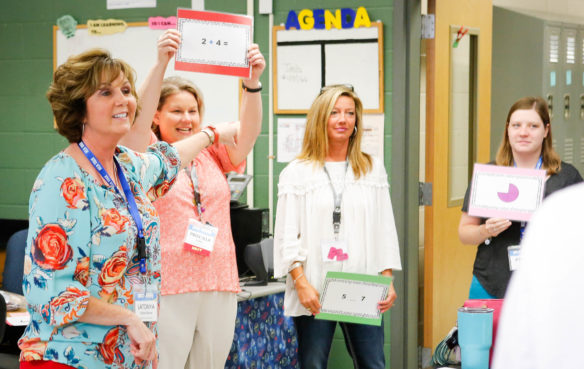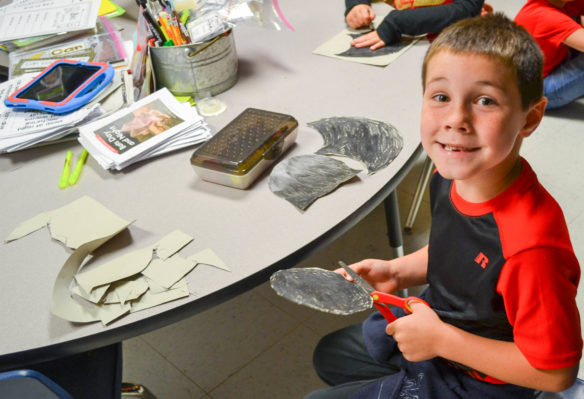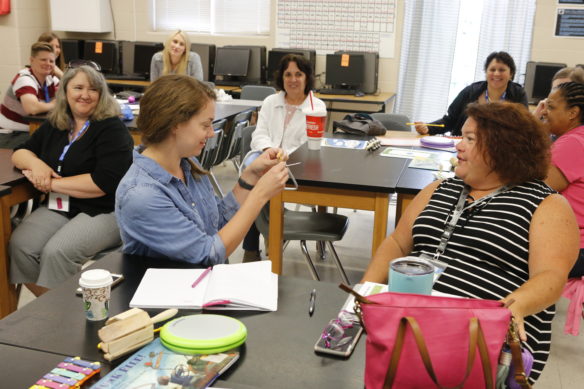
LaTonya Taylor-Rowe, a 1st-grade teacher at Highland Elementary School (Johnson County), points to fellow teachers who are demonstrating one of the songs she uses to help her students better understand mathematics standards during the Let’s TALK: Conversations About Effective Teaching and Learning conference in Lexington.
Photo by Mike Marsee, June 12, 2017
By Mike Marsee
michael.marsee@education.ky.gov
LaTonya Taylor-Rowe saw that some of her students’ problems with mastering mathematics skills were multiplying, so she added new elements to help engage them.
Her solution became WAM2 – writing, art, music and mathematics – a means of introducing elements from other content areas to help students better understand mathematics standards. It’s a strategy that Taylor-Rowe used in her 4th-grade classroom at Highland Elementary (Johnson County) for several years.
“The things that I saw that were helpful to them, that they related well to, were things like art and music,” Taylor-Rowe said. “I wanted to make sure I touched on that with those kids, and I wanted to bring that into math.”
That might mean using a song to lead into a mathematics lesson, or it might mean using one of the other content areas to check for understanding.
“This isn’t necessarily just used for an opening of a lesson,” she said. “It might be used in the middle or at the end of a lesson,” she said. “I may have taught a skill that day and then turned the students loose to create some kind of art piece related to the lesson or a rap or a song that could be used as an exit slip to measure the students’ understanding at the end of the lesson.”
Taylor-Rowe, who taught 4th grade for nine years before moving to a 1st-grade classroom this year, recently used such an exit slip with her 1st-grade students after a lesson on doubles (one plus one, two plus two, et cetera) during a week in which bats were the classroom theme.
“We did all kinds of things with that. We had a song with it and the kids created bats. On the wings of their bats they wrote doubles that they were familiar with and that they could answer,” she said. “That gave me an exit slip for that day so I could see if they were getting the concept. I could see which doubles they favored and which ones they needed more work on. If everybody leaves out nine plus nine, then I can see that’s something we need to work more on.”
Taylor-Rowe said the results of her initiative have been reflected in students’ test scores. She said her 4th-grade students’ scores rose in all but one year in which she used WAM2.
“Overall my test scores would increase each year, and for a couple of years my test scores in 4th-grade math were the highest in the district,” she said. “I do think WAM2 was very effective.”
Taylor-Rowe said she worked closely with colleagues Heather Estep and Amanda O’Bryan to incorporate more writing across the curricula. By her fourth or fifth year with 4th-grade students, she was using much more music and art in her mathematics lessons as well.
“Any of the concepts, any of the standards that we taught, we always tried to make sure I had some kind of writing, some kind of art, some kind of music,” she said. “Sometimes I created those and sometimes the students developed those.
“Every year my students struggled with multiplication facts, and they started creating their own raps and songs and adding music to them. I borrowed instruments from our music teacher, everything from snare drums to keyboards to xylophones.”

Tatum Ousley, a 1st-grade student at Highland Elementary School, cuts out bat wings during an art project that is part of a mathematics lesson in LaTonya Taylor-Rowe’s class. Rowe uses writing, art and music in her classes to help her students master mathematics skills.
Photo submitted, Oct. 23, 2017
During the Halloween season, students created their own Halloween-themed stories involving multiplication. The stories might be accompanied by torn paper art – such as of a haunted house – that could be used in the math problem.
In winter, students might create a depiction of a snowman, then be asked to determine the measurements of the water left if the snowman melted.
“To add all these other subjects in with the math, it makes it more meaningful to the students,” Taylor-Rowe said. “At the end of the year, I could ask them, ‘Do you remember when you wrote this rap?’ and we’d share those. They could remember that lesson or they could look at the journal writing they had done and review. They had ownership of it, and it made it much easier to review.”
Taylor-Rowe said she also uses mathematics to connect with what students are learning in other subject areas, such as when her 4th-grade students read “Bunnicula” with their language arts teacher.
“I ran with what she was doing in reading class, and my kids created doghouses for Harold (a character in the book) using everything from shoeboxes to wood,” she said. “At the time we were talking about measurements and converting inches to centimeters. I gave them a specific range of measurements, and they measured each other’s doghouses to make sure they were within those limits.
“It was STEM-related because they had to create the doghouse and be creative with that they put in the doghouse, and there was a writing element in which they wrote a letter to Harold encouraging him to come live in their doghouse and telling him why theirs was the best.”
Helping students to see how mathematics connects to everyday life is a valuable skill, said Erin Chavez, an elementary mathematics consultant at the Kentucky Department of Education.
“Mathematics surrounds us in our daily life, and providing opportunities for our learners to see math in other content areas allows connections to be made,” Chavez said. “Ensuring that all learners are engaged in high-quality tasks that promote problem-solving and reasoning is an effective teaching practice that can help our students see the everyday life of mathematics.”

A teacher plays the triangle as teachers demonstrate songs they created to help students master mathematics skills during a presentation by LaTonya Taylor-Rowe at the Let’s TALK: Conversations About Effective Teaching and Learning conference in Lexington.
Photo by Mike Marsee, June 12, 2017
Taylor-Rowe shared her WAM2 experiences and ideas last summer at the Let’s TALK: Conversations About Effective Teaching and Learning conference in Lexington. Within a few minutes, she had teachers making up rhymes and using xylophones, wooden sticks and even a triangle to accompany their math-themed songs.
“A couple of them have said to me they were using some of this in their classroom and it was going very well,” she said.
Taylor-Rowe said the WAM2 concept will work across all elementary grade levels. She has made some changes this year to make it work for her 1st-grade students.
“I created this for math, but we have been using it in reading and science and social studies. We’re incorporating it in every area that we’re studying,” she said.
She said WAM2 has benefitted her as well as her students.
“It has added a spark to my teaching,” Taylor-Rowe said. “Every year I think, ‘What’s something new I can add?’ and I get as excited as these kids get about what’s going on in the classroom. They’re creating raps and songs and art pieces, and I’m as excited as they are to see the finished product and to see them learning.”
MORE INFO …
LaTonya Taylor-Rowe latonya.rowe@johnson.kyschools.us




Leave A Comment